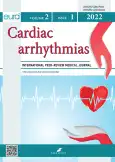Катетерная абляция устойчивой идиопатической желудочковой тахикардии из выходного тракта правого желудочка у беременной женщины без использования рентгеноскопии
- Авторы: Говорова Ю.О.1, Першина Е.С.2, Тюков П.А.3, Алехнович А.В.1, Лищук А.Н.1, Громыко Г.А.1,4
-
Учреждения:
- 3-й Центральный военный клинический госпиталь им. А.А. Вишневского МО РФ
- Городская клиническая больница № 1 им. Н.И. Пирогова ДЗ города Москвы
- Вологодская Областная Клиническая Больница
- Медицинский институт непрерывного образования, Московский государственный университет пищевых производств
- Выпуск: Том 2, № 1 (2022)
- Страницы: 41-46
- Раздел: Клинические случаи
- URL: https://journal-vniispk.ru/cardar/article/view/101549
- DOI: https://doi.org/10.17816/cardar101549
- ID: 101549
Цитировать
Полный текст
Аннотация
Цель. Представлен случай диагностического алгоритма у пациентки с пароксизмальной устойчивой идиопатической желудочковой тахикардией с гемодинамическим компромиссом, рефрактерной к антиаритмической терапии, и возможностей радиочастотной абляции (РЧА) без рентгеноскопии в наиболее уязвимом первом триместре беременности.
Материалы и методы. В 2020 году в нашем отделении выполнено 739 операций у небеременных пациентов. 545 весьма успешных нефлюороскопических РЧА по поводу аритмий проведены с использованием 3-х мерной навигационной системы, в их числе 47 пациентов с идиопатическими желудочковыми тахикардиям (ЖТ) из выходного отдела правого желудочка (ВТПЖ).
В нашу больницу госпитализирована 38-летняя женщина на 10-11-й неделе третьей беременности со структурно нормальным сердцем и устойчивой рецидивирующей тахикардией с широкими QRS-комплексами, частыми ЖЭ при холтеровском мониторинге, с жалобами на пресинкопе и одышку. Тахикардия была рефрактерна к антиаритмическим препаратам. Нами представлен наш первый, успешный опыт нефлюороскопической РЧА устойчивой идиопатической тахикардии с клиническими проявлениями из ВТПЖ у беременной пациентки.
Результаты. Наш случай говорит о том, что методика может быть применима в тех редких случаях, когда имеет место аритмия с гемодинамическим компромиссом, рефрактерная к антиаритмическим препаратам, и рентгеноскопия противопоказана.
Выводы. Представлен случай возможного диагностического алгоритма у пациентки с пароксизмальной устойчивой идиопатической желудочковой тахикардией с гемодинамическим компромиссом, рефрактерной к антиаритмической терапии, и возможностей радиочастотной абляции без рентгеноскопии в наиболее уязвимом первом триместре беременности.
Полный текст
Открыть статью на сайте журналаОб авторах
Юлия Олеговна Говорова
3-й Центральный военный клинический госпиталь им. А.А. Вишневского МО РФ
Email: jgovorova9@gmail.com
ORCID iD: 0000-0001-7096-310X
врач-кардиолог, Кардиохирургический центр, отделение кардиохирургического лечения пациентов с нарушениями ритма сердца
Россия, Московская область, КрасногорскЕкатерина Сергеевна Першина
Городская клиническая больница № 1 им. Н.И. Пирогова ДЗ города Москвы
Email: pershina86@mail.ru
ORCID iD: 0000-0002-3952-6865
SPIN-код: 7311-9276
канд. мед. наук
Россия, МоскваПавел Александрович Тюков
Вологодская Областная Клиническая Больница
Email: ptukov@mail.ru
ORCID iD: 0000-0001-8974-0416
сердечно-сосудистый хирург, отделение кардиохирургическое, Кардиохирургический Центр
Россия, ВологдаАлександр Владимирович Алехнович
3-й Центральный военный клинический госпиталь им. А.А. Вишневского МО РФ
Автор, ответственный за переписку.
Email: vmnauka@mail.ru
ORCID iD: 0000-0001-8851-9138
SPIN-код: 3507-2688
д-р мед. наук, профессор
Россия, Московская область, КрасногорскАлександр Николаевич Лищук
3-й Центральный военный клинический госпиталь им. А.А. Вишневского МО РФ
Email: AlexLischuk@yandex.ru
ORCID iD: 0000-0003-0285-5486
SPIN-код: 1255-2035
д-р мед. наук, профессор
Россия, Московская область, КрасногорскГригорий Алексеевич Громыко
3-й Центральный военный клинический госпиталь им. А.А. Вишневского МО РФ; Медицинский институт непрерывного образования, Московский государственный университет пищевых производств
Email: gromyko2010@list.ru
ORCID iD: 0000-0002-7942-9795
SPIN-код: 3041-8555
канд. мед. наук
Россия, Московская область, Красногорск; МоскваСписок литературы
- Priori S.G., Blomström-Lundqvist C., Mazzanti A., et al. 2015 ESC Guidelines for the management of patients with ventricular arrhythmias and the prevention of sudden cardiac death: The Task Force for the Management of Patients with Ventricular Arrhythmias and the Prevention of Sudden Cardiac Death of the European Society of Cardiology (ESC) // Eur Heart J. 2015. Vol. 36, No. 41. P. 2793–2867. doi: 10.1093/eurheartj/ehv316
- van Hagen I.M., Boersma E., Johnson M.R., et al. Global cardiac risk assessment in the registry of pregnancy and cardiac disease: Results of a registry from the European Society of Cardiology // Eur J Heart Fail. 2016. Vol. 18, No. 5. P. 523–533. doi: 10.1002/ejhf.501
- Regitz-Zagrosek V., Roos-Hesselink J.W., Bauersachs J., et al. 2018 ESC Guidelines for the management of cardiovascular diseases during pregnancy // Eur Heart J. 2018. Vol. 39, No. 34. P. 3165–3241. doi: 10.1093/eurheartj/ehy340
- Haugaa K.H., Haland T.F., Leren I.S., et al. Arrhythmogenic right ventricular cardiomyopathy, clinical manifestations, and diagnosis // Europace. 2016. Vol. 18, No. 7. P. 965–972. doi: 10.1093/europace/euv340
- Corrado D., Perazzolo Marra M., Zorzi A., et al. Diagnosis of arrhythmogenic cardiomyopathy: The Padua criteria // Int J Cardiol. 2020. Vol. 319. P. 106–114. doi: 10.1016/j.ijcard.2020.06.005
- Bauersachs1 J., König T., van der Meer P., et al. Pathophysiology, diagnosis and management of peripartum cardiomyopathy: a position statement from the Heart Failure Association of the European Society of Cardiology Study Group on peripartum cardiomyopathy // Eur J Heart Fail. 2019. Vol. 21, No. 7. P. 827–843. doi: 10.1002/ejhf.1493
- Yamada T. Idiopathic ventricular arrhythmias Relevance to the anatomy, diagnosis and treatment // J Cardiol. 2016. Vol. 68, No. 6. P. 463–471. doi: 10.1016/j.jjcc.2016.06.001
- Li M.-M., Sang C.-H., Jiang C.-X., et al. Maternal arrhythmia in structurally normal heart: Prevalence and feasibility of catheter ablation without fluoroscopy // Pacing Clin Electrophysiol. 2019. Vol. 42, No. 12. P. 1566–1572. doi: 10.1111/pace.13819
- Guangzhi C., Ge S., Renfan X., et al. Zero-fluoroscopy catheter ablation of severe drug-resistant arrhythmia guided by Ensite NavX system during pregnancy: Two case reports and literature review // Medicine. 2016. Vol. 95, No. 32. P. e4487. doi: 10.1097/MD.0000000000004487
Дополнительные файлы










